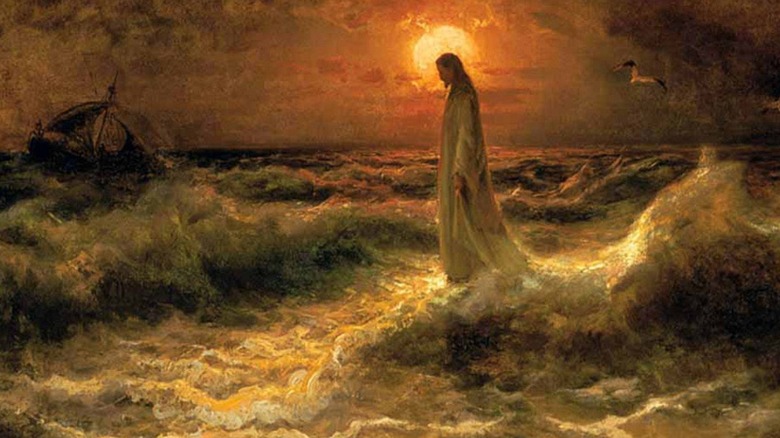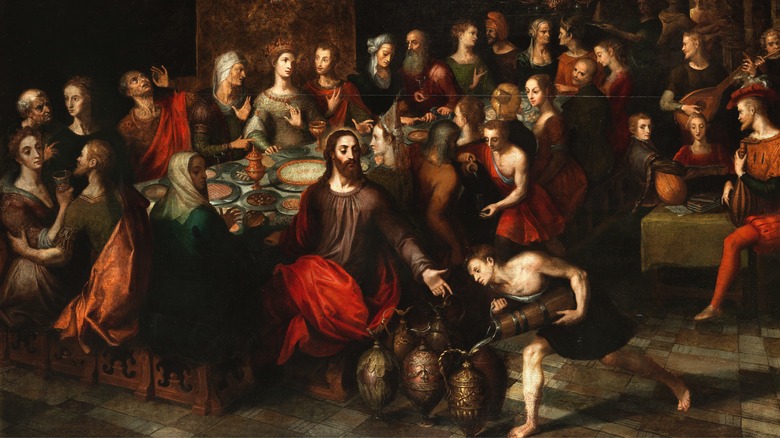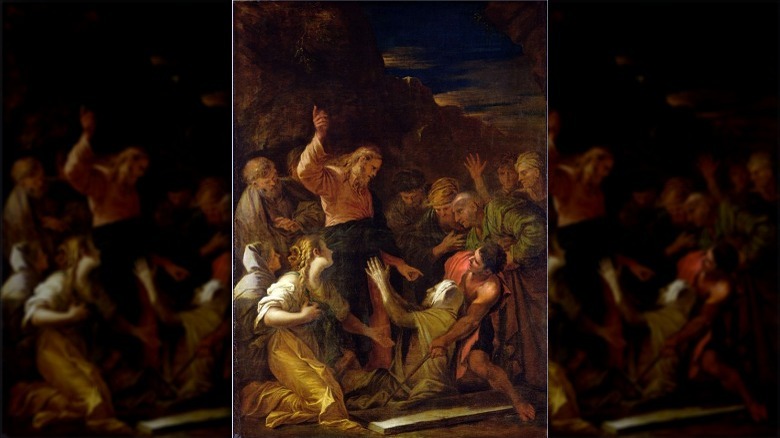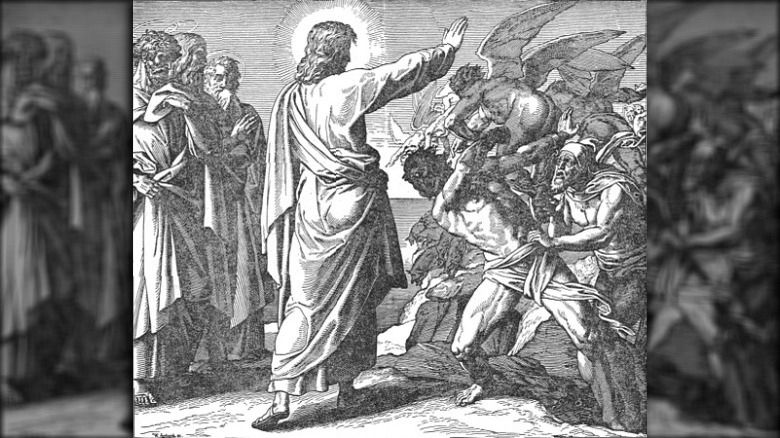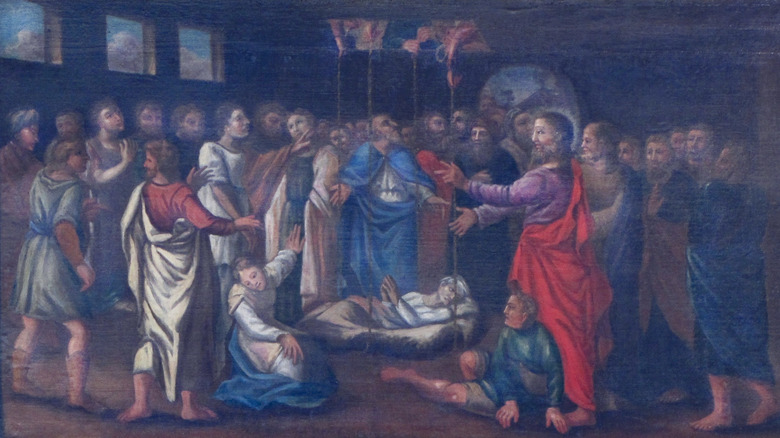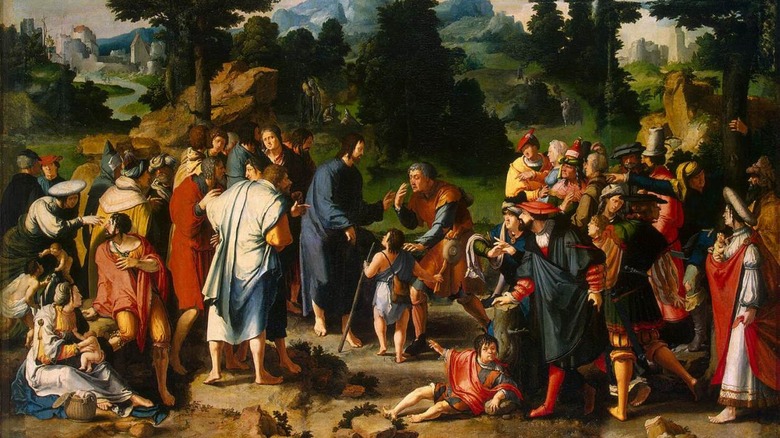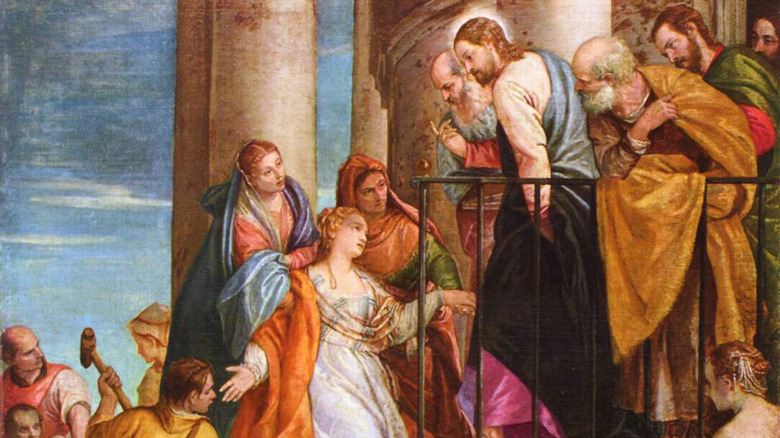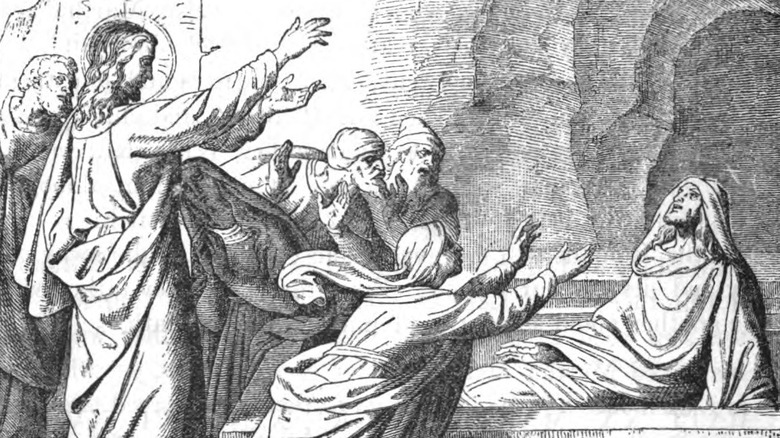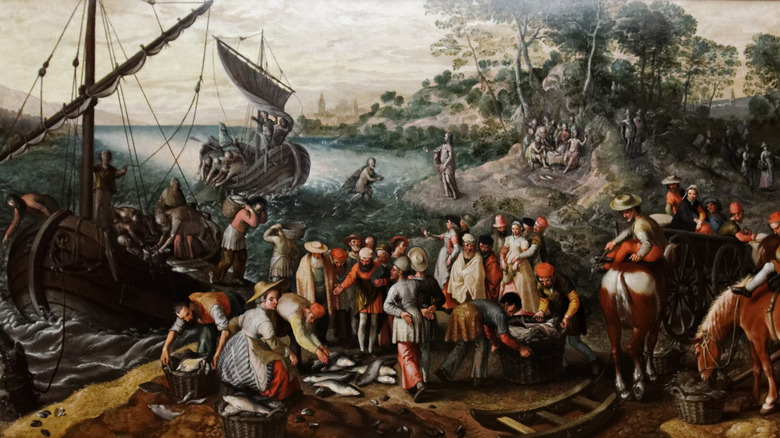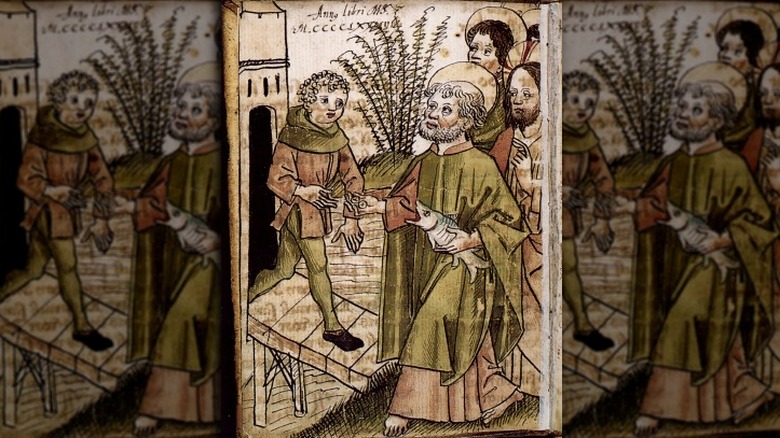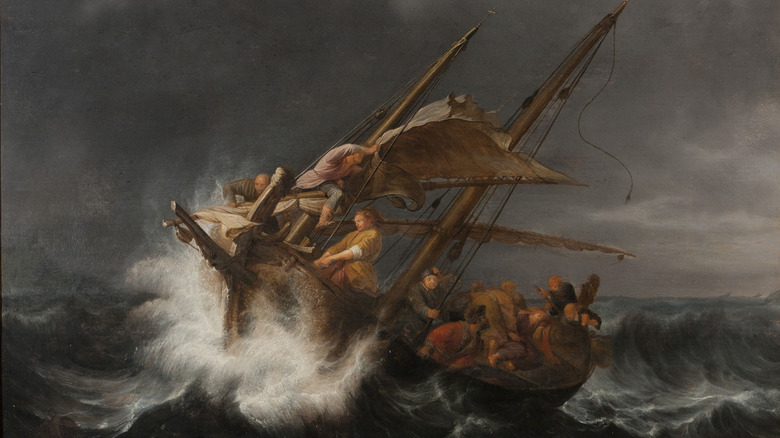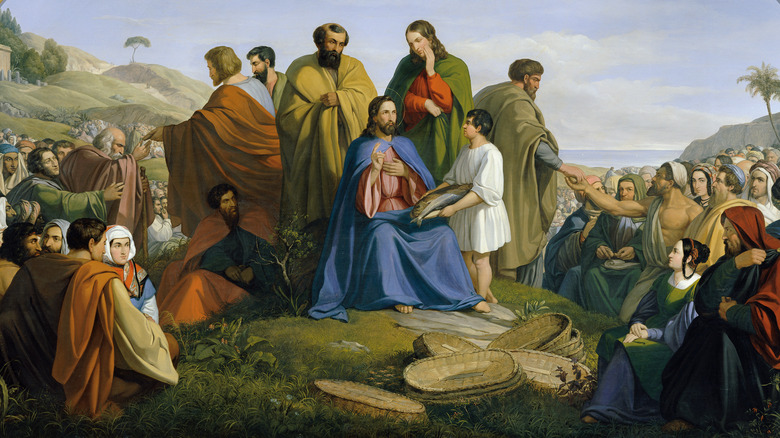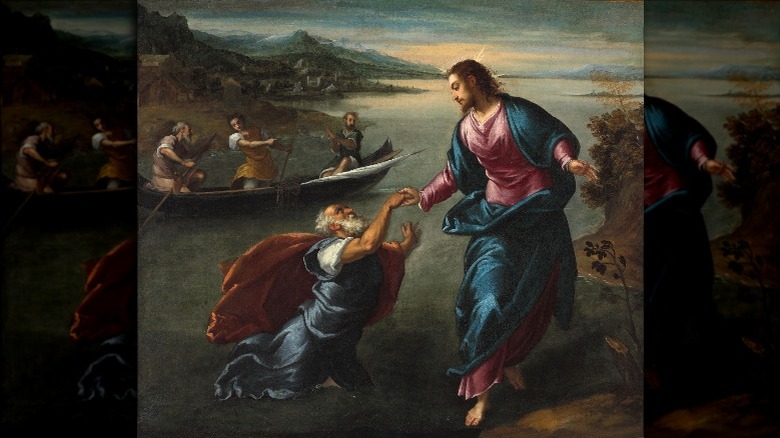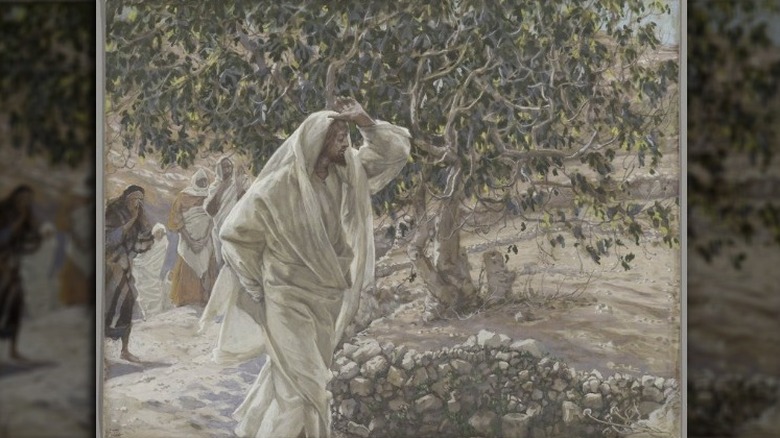Every Miracle Jesus Performed In The Bible
According to the New Testament, Jesus Christ was the Son of God who became human in order to instruct the world about the imminent arrival of the Kingdom of Heaven, and one of the major ways Jesus tried to establish his power and authority was with miracles. Although the Gospel of John says that if all the miracles of Jesus were written down it would fill up more books than the world has room for, as Learn Religions explains, the books we do have record a total of 37 miracles of Jesus, if you don't count things like the virgin birth, the resurrection, or his ascension into heaven.
Three of the Gospels –- Matthew, Mark, and Luke — are known as the Synoptic Gospels because they tend to largely agree on their accounts of Jesus' life and ministry. As a result, many of these miracles are told from multiple points of view. In contrast, the Gospel of John is actually built around the idea of the signs and wonders of Jesus as the proof of his divinity. Here, then, is a complete list of the wondrous deeds of Jesus Christ, according to the canonical Gospels.
Turning water into wine
One of Jesus' best known miracles, one with which even non-Christians are likely familiar, is also, according to the Gospel of John, his very first miracle: changing water to wine at the wedding at Cana. But despite its great fame, this miracle is only recorded in John's Gospel, which is specifically framed around the miracles of Jesus to show his power over life and death, like a geometric proof demonstrating the feasibility and inevitability of Christ's resurrection. The story of the water that became wine occurs in John 2:1-11 when a wedding to which Jesus and his disciples had been invited runs out of wine. Jesus' mother Mary, also at the wedding, asks Jesus to help, and Jesus, who had not yet revealed his divine nature, only reluctantly agrees. Six 30-gallon water jars that were on hand for purification purposes are soon filled with wine considered better than what the groom had brought out before, and Jesus' disciples are amazed.
According to Got Questions, while Jesus performed this miracle to placate his mother and to save his host from some embarrassment, his primary goal was to display his glory so that his disciples might believe in his power over nature. Jesus' miracles were never magic tricks for attention; they always reveal a greater truth.
Healing the sick
The majority of the miracles of Jesus have to do with the healing of the sick as a display of his great compassion for human suffering. As Learn Religions explains, some miracles of Jesus were done as signs of his divine authority, but some were done simply to meet a basic human need. Many of Jesus' healing miracles fall into this category. Sometimes he healed specific people at the request of a loved one, like when he healed the dying son of an official in Capernaum (John 4:43-54), or when he cured his disciple Simon Peter's mother-in-law when she was laid out with fever (Matthew 8:14-15, Mark 1:29-31, Luke 4:38-39), but the Gospels also show him as healing huge crowds of people who came to him seeking relief to their suffering (Matthew 8:16-17, Mark 1:32-34, Luke 4:40-41). So great was his healing power that even those who touched a tassel on his robe were healed (Matthew 14:34-36, Mark 6:53-56).
One of the common illnesses that Jesus encounters is leprosy, a skin disease that often led to rejection from society. Jesus' willingness to help people with leprosy shows the depths of his compassion. He healed one man who approached him (Matthew 8:1-4, Mark 1:40-45, Luke 5:12-14) and even 10 at once in Luke 17:11-19.
Driving out evil spirits
Closely associated with acts of healing is Jesus' driving out of evil spirits. Demons and evil spirits were said to cause physical and mental illnesses in people, and driving them out caused great relief to those suffering possession. As Got Questions explains, Jesus' acts of expelling demons show his power and authority over the supernatural world. When Jesus encounters a demon-possessed man in Capernaum, even the demon is forced to confess Jesus' control over him (Mark 1:21-27, Luke 4:31-38). Jesus shows that he came for all humanity and not just the Jews when he drives a demon out of a Gentile woman's daughter (Matthew 15:21-28, Mark 7:24-30), and he likewise shows his disciples that even the smallest amount of faith will give them power over the demons (Matthew 17:14-20, Mark 9:14-29, Luke 9:37-43). He gives his famous "a house divided against itself cannot stand" lesson when he is accused of being demonically powered after driving an unclean spirit that caused a man to be blind and unable to speak (Matthew 12:22-23, Luke 11:14-23).
Likely the most famous account of Jesus driving out evil spirits is when he encounters a man possessed by so many demons that they call themselves Legion. The demons ask Jesus to send them into pigs rather than be tormented by heavenly power. When he complies, the newly demonic herd of pigs rushes into the sea and drowns (Matthew 8:28–33, Mark 5:1-20, Luke 8:26-39).
Causing the paralyzed to walk
While the Gospels report that Jesus healed a great number of maladies during his ministry, two of the most commonly cited are allowing the paralyzed to walk and the blind to see. In the case of the former, there are definitely multiple instances of this particular miracle recorded in the Gospels. The earliest such healing occurs when a Roman centurion approaches Jesus and asks him to heal his servant, who is lying paralyzed in bed at home (Matthew 8:5-13, Luke 7:1-10). This encounter is notable for showing that Jesus came to heal Gentiles as well as Jews, in addition to showing his power to heal people at a distance.
As the BBC explains, possibly the most famous example of Jesus causing a paralytic to walk is the story of the four friends who carried their quadriplegic friend on a mat and lowered him through a hole in the ceiling hoping that Jesus could heal him (Matthew 9:1-8, Mark 2:1-12, Luke 5:17-26). This story is the source of Jesus' famous catchphrase, "Pick up your mat and walk." Other instances of Jesus healing paralysis include healing a man by the miraculous healing pool of Bethesda (John 5:1-15) and healing a woman at a synagogue who had been unable to walk for 18 years (Luke 13:10-17).
Giving sight to the blind
Bringing sight to the blind is another health-related miracle that Jesus employed on multiple occasions. As Bible Study Tools explains, the writers of the Gospels use the healing of the blind to illustrate the importance of faith–a spiritual trust in things unseen–versus literal eyesight. The account of a healing of a blind person most repeated in the Gospels is that of Bartimaeus, a blind beggar who is healed by the power of his faith when he trusts to approach Jesus for help (Matthew 20:29-34, Mark 10:46-53, Luke 18:35-43). A similar incident occurs in Matthew 9:27-31, when Jesus heals not one, but two different blind men who ask him to have mercy on them.
While in these encounters Jesus heals the blind simply by the power of their faith and his own words, the account in Mark 8:22-26 shows Jesus employing a different method. When a blind man is brought to Jesus at the city of Bethsaida, Jesus responds by spitting in the blind man's eyes. He uses a similar method in John 9:1-12 when he passes by a man blind from birth. Instead of spitting directly into the man's eyes, however, here he spits into the dirt to make mud that he rubs into the man's eyes. When the man washes away the mud, he is able to see for the first time.
Various other acts of healing
While many of Jesus' healing miracles fall into broad categories such as blindness, paralysis, or leprosy, there are several such miracles that are unique over the course of his ministry. Got Questions states that Jesus' various acts of healing are rarely solely about the alleviation of physical pain for those he helps but also serve to show Jesus' authority over life and the natural world in his role as the Son of God. One such example is when he heals a man with a withered hand (Matthew 12:9-14, Mark 3:1-6, Luke 6:6-11) on the Sabbath, which is a controversial move among the Jews, but Jesus uses the opportunity to present himself as Lord of the Sabbath, but also to show how mercy and compassion are more important than the letter of the law.
Another notable healing comes when a woman who had been experiencing continuous menstrual bleeding for 12 years, and who would have been considered unclean as a result, is healed when she merely touches the corner of Jesus' robe (Matthew 9:20-22, Mark 5:25-34, Luke 8:42-48). Likewise, he heals a man who cannot speak in Matthew 9:32-34, a man who cannot hear or speak in Mark 7:31-37, and a man afflicted with swelling in Luke 14:1-6. And in a show of real compassion, he heals the ear of one of the men who came to arrest him when one of his disciples cut it off in Luke 22:50-51.
Raising the dead
Although Jesus' healing miracles are great examples of his power as the Son of God, no miracle serves to show his authority over life and death more than raising the dead. Jesus only does this showstopper of a miracle a few times, but the effect helps to foreshadow his own return from the dead following the crucifixion. The Gospel of Luke 7:11-17 gives the account of Jesus raising the son of a widow from the dead as his coffin is being carried out of his home. As the BBC explains, this not only displays Jesus' triumph over the grave but establishes him to the people of Judea as part of a long legacy of miraculous figures, as the raising of the widow's son echoes a miracle performed by the prophet Elijah centuries before. Similarly, he raises the daughter of Jairus, one of the temple officials, by saying, "She isn't dead, but only sleeping," to show that death is a temporary condition in the face of the coming resurrection (Matthew 9:18-26, Mark 5:21-43, Luke 8:40-56).
Jesus' most famous resurrection other than his own, of course, was that of his friend Lazarus, the brother of his followers Mary and Martha of Bethany. The account in John 11:1-45 includes two very notable verses: first, the shortest verse in the Bible – "Jesus wept" – showing Jesus' reaction to his fallen friend; and second, Jesus' declaration to Martha, saying "I am the resurrection and the life. The one who believes in Me, even if he dies, will live."
Two miraculous catches of fish
It was not only human health that Jesus showed power over with his miracles, however. As Got Questions explains, many of Jesus' miracles illustrate his power over the greater natural world. Since many of Jesus' followers were fishermen, it's not entirely surprising that a number of his displays of power over nature involved the waters of the Sea of Galilee. For example, the account in Luke 5:1-11 shows Jesus recruiting his earliest disciples–Simon Peter and James and John, the sons of Zebedee–by telling them to throw their nets in the water after a long and fruitless day of fishing. The skeptical men do as he says, only to haul in so many fish that two boats could hardly hold them without tipping over. It is at this point that Jesus says to follow him and become not fishermen, but fishers of men, a classic Jesus line.
The Gospel of John also records a miraculous catch of fish, but while the version in Luke happens at the very beginning of Jesus' ministry, the one in John 21:4-11 happens at the very end, after Jesus' resurrection but before his ascent into Heaven. In this instance, he helps the disciples catch a huge haul in order to prove his identity after returning from the dead.
Finding money in a fish's mouth
While many of Jesus' miracles are extremely well known to the point of being common tropes and even proverbial expressions, here's a miracle you might not have heard of in Sunday school. In Matthew 17:24-27, Jesus and his disciples are in the town of Capernaum when they are approached by tax collectors asking for the double drachma tax. This is a tax paid by Jewish men to support the temple, valued at about the cost of two sheep. Jesus tells Simon Peter that as the sons of God, they should be exempt from the tax, but to avoid causing trouble, they will pay it. Jesus sends Simon to the sea to catch a fish, telling him that a coin large enough to pay the tax will be in its mouth, all of which comes to pass.
According to Forerunner Bible Study, this incident displays Jesus' instruction not to needlessly offend someone, even though he should be exempt from the tax. Likewise, helping Simon catch just the right fish shows his power over all creation.
Calming the storm
Another display of Jesus' power over the elements comes when he and his disciples are on a boat that gets hit by a violent storm. While the disciples are terrified that the storm will sink the ship, Jesus is sleeping peacefully below decks. When the frightened disciples wake him up in fear for their lives, Jesus tells them not to worry and calms the storm. This causes his followers to marvel that "even the winds and the sea obey Him!" (Matthew 8:23-27, Mark 4:35-41, Luke 8:22-25).
The BBC explains that this specific miracle would have had a very resonant meaning for Jesus' Jewish disciples: Hebrew scriptures including the Psalms make it very clear that only one being has the power to control the wind and the waves, God himself. For Jesus' disciples, his calming of the storm was a powerful statement and concrete confirmation of his divinity.
Feeding the multitudes
While numerous miracles of Jesus are recorded in more than one of the Gospels, there is one and only one that appears in all four. That miracle is the famous feeding of the 5,000, which is reported in Matthew 14:13-21, Mark 6:30-44, Luke 9:10-17, and John 6:1-15. In the various accounts of this miracle, Jesus has accumulated an enormous crowd who have seen the amazing miracles he has performed. When Jesus tells his disciples to feed the people who have gathered, they respond that the only food they have is five loaves of bread and two fish. Jesus blesses this small offering and when it is distributed, it proves to be enough for 5,000 men (plus women and children) and to have 12 baskets left over. As Got Questions explains, Jesus' angry response to the people the next day when they ask him to feed him again shows that his miracles are designed more to fill the people's spiritual needs than their physical ones, as they had overlooked the significance of the miracle in the face of getting a free meal.
While most people are pretty familiar with the account of the feeding of the 5,000, somewhat lesser known is the fact that Jesus did basically this same miracle again with a crowd of 4,000 people and a slightly different amount of bread and fish, according to Matthew 15:32-39 and Mark 8:1-13.
Walking on water
In three of the four Gospels, the story of the feeding of the 5,000 is immediately followed by one of Jesus' most famous miracles, one that has become synonymous with the idea of being supernaturally good: walking on water. In Matthew 14:22-33, Mark 6:45-52, and John 6:16-21, the disciples have boarded a boat following the miracle of the loaves and fish, while Jesus has stayed on shore to pray. Soon the disciples see a figure approaching their boat by walking on top of the waves. They fear that a ghost is coming, but Jesus calls out to them not to be afraid. In Matthew's account, Peter decides to walk out on the water himself to go meet his master. At first, his faith allows him to tread on the sea, but soon he becomes afraid of the waves and begins to sink until he is saved by Jesus, who rebukes him for his lack of faith.
Why does Luke omit the story of Jesus walking on water? Christianity.com suggests it's because Luke wasn't a follower of Christ during his earthly ministry and wasn't an eyewitness to the event, but this relies on the traditional view that the authors of the Gospels were the actual apostles (or in Mark's case, a scribe for one). As Cambridge University Press explains, however, the more scholarly explanation is that the author of Luke was simply missing this account from the sources he used in compiling his Gospel.
Cursing a fig tree
One of Jesus' last miracles is also one of his strangest. The accounts in Matthew 21:18-22 and Mark 11:12-14 show a hungry Jesus approaching a fig tree looking for fruit. When he finds nothing but leaves on the tree, he curses the tree never to bear fruit again. When the disciples see the tree again, it has withered. When the disciples ask how Jesus managed to curse the tree, he explains that the power of faith will enable them to do that and much more.
People have debated the meaning of Jesus cursing the tree for centuries. Was he just hangry, is Jesus that petty, or is there a greater symbolic meaning? Author and pastor Dr. Ray Pritchard explains that this scene is a parable in which the tree represents the nation of Israel, and Jesus' frustration at the tree represents his (and consequently God's) frustration with the people of Israel's failure to bear the fruit of righteousness. The juxtaposition of the fig tree story next to Jesus' wild assault on the temple moneylenders seems to lend credence to this interpretation.
